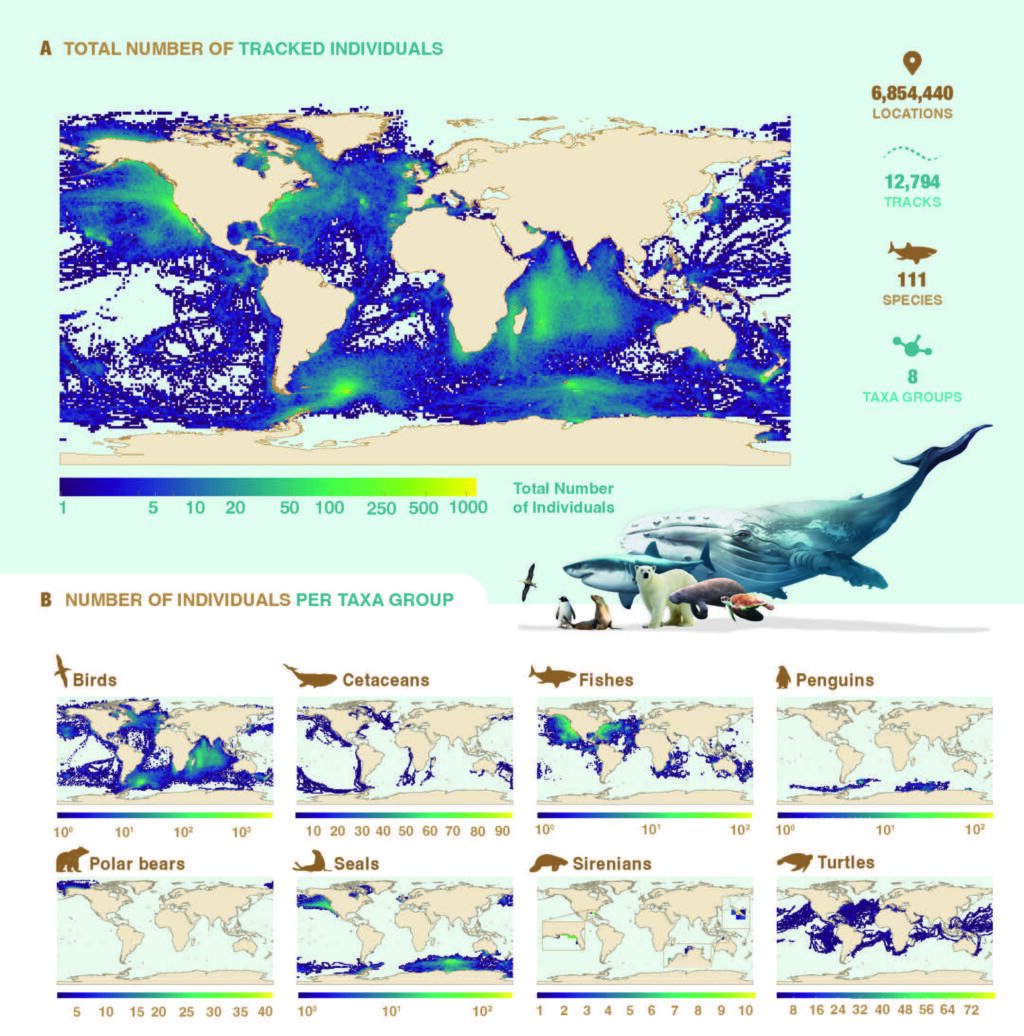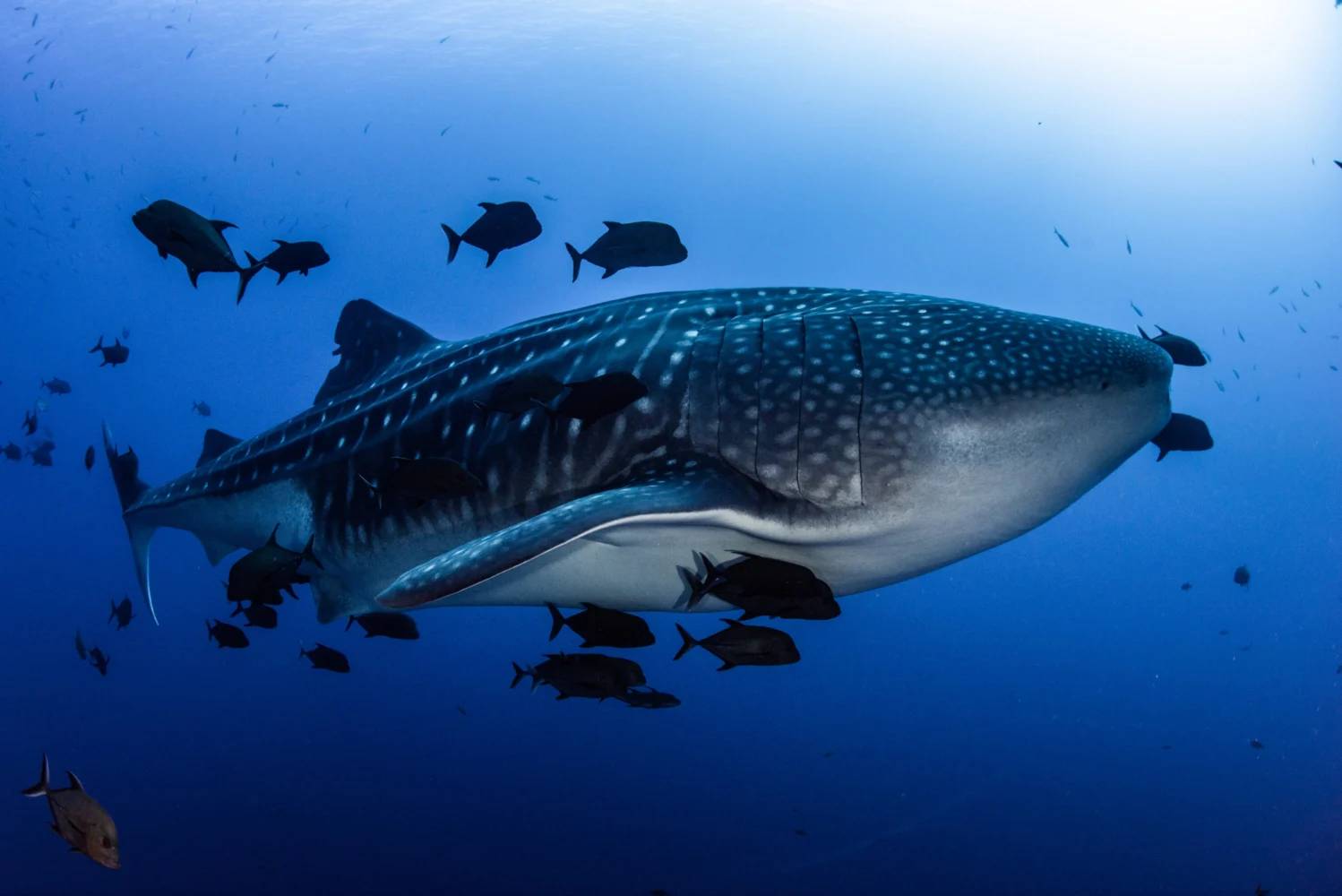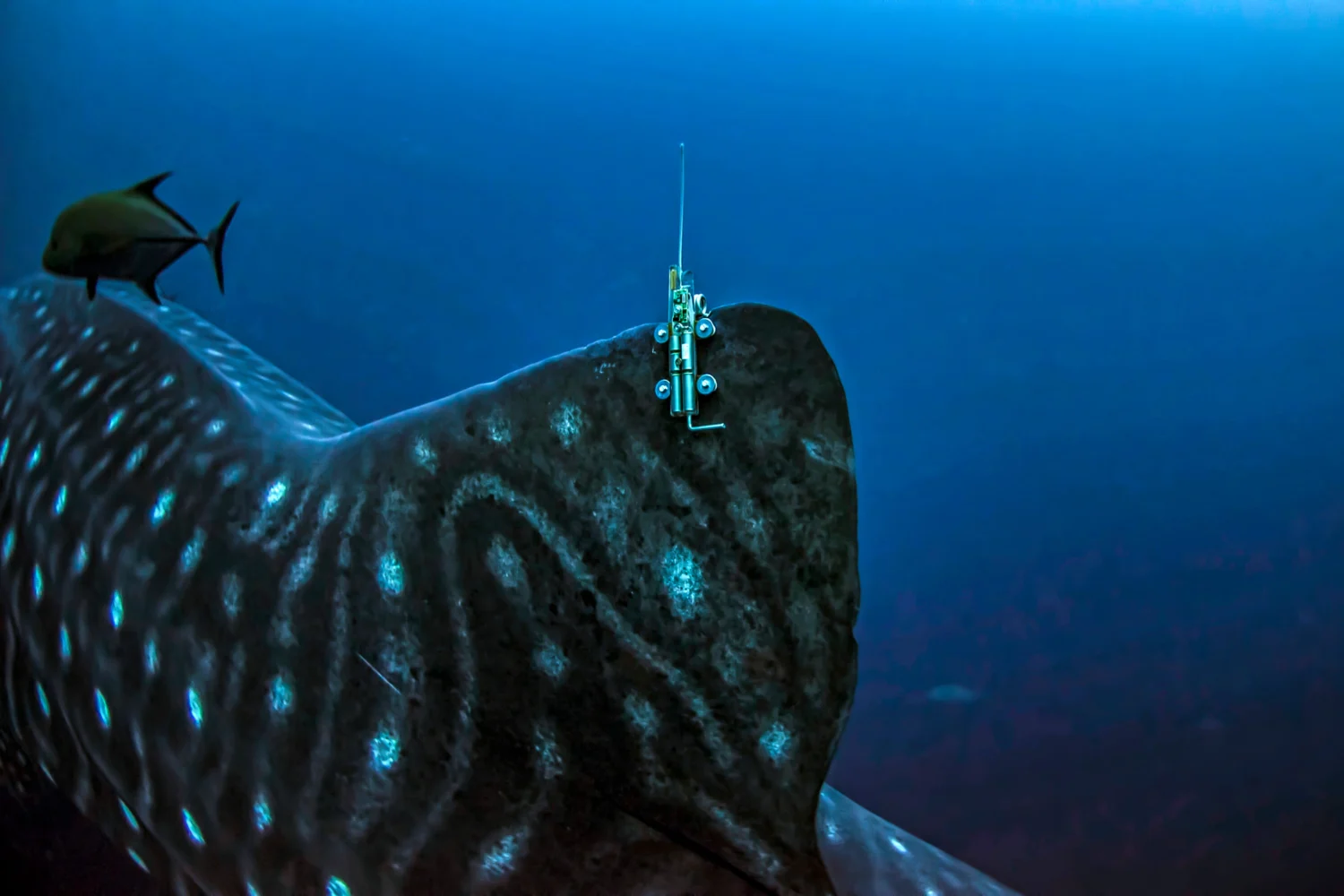Mega moves for marine megafauna
More than 75% of the most important places where the ocean’s biggest animals are migrating, or feeding, breeding, and resting, overlap with serious threats to their survival.
A massive global effort by nearly 400 scientists using 30 years’ worth of tracking data has identified where protection must be prioritised for marine giants – and shows that fishing, shipping, pollution, and rising sea temperatures are obstacles to survival, and threaten the most critical parts of large ocean creatures’ life cycles.
Nearly one-third of all the ocean’s titans – from turtles and whales, to sharks, seals, seabirds and dugongs – are threatened with extinction. While achieving our global commitment of 30% ocean protection by 2030 will go a long way to help stop destruction, it will still fall woefully short of halting losses entirely, with 60% of critical habitats left vulnerable to threats. But there is hope yet: the study, published in the journal Science, details where protected area expansion could best benefit our ocean’s biggest biodiversity ambassadors, and outlines what other measures should receive equally urgent implementation to curb catastrophe in unprotected waters.
What are marine megafauna – and why are we worried about them?
The last of the great auks was crushed by a fisherman’s boot. It’s sadly emblematic of the impact we have had on some of our planet’s largest creatures: in their pursuit of the last pair of great auks on the shores of Eldey Island near Iceland (they captured and killed both the male and female), a fisher trod on the birds’ only incubating egg. The last of its kind on the planet.
And so, the fate of several of our ocean’s largest modern inhabitants played out: the nearly 10-ton Steller’s sea cow was exterminated in just 27 years after its discovery in 1741 by German naturalist Georg Wilhelm Steller. The Japanese sea lion was hunted to extinction by the 1950s. In the past 500 years, somewhere between 20 and 24 marine species of all manner of sizes – ranging from algal plants to marine mammals – have gone extinct. At face value, that may not sound like much. It certainly suggests that the capacity of the ocean to endure exploitation, and recover from change when managed, differs from that of land-based ecosystems – but all indications are that we are accelerating the rates of decline across many taxa (groups of animals and plants), and risk significantly more potential extinctions in the future.
We know the critical places where our ocean’s giants spend their time – now, we need to protect them. Photo © Christopher Vaughan-Jones
The threats to the survival of the largest animals in our oceans are particularly pronounced. Today, nearly one-third of marine megafauna are threatened with extinction. Generally, large animals like whales, many species of sharks, seals, sea lions and some of the biggest seabirds, are what ecologists term “K-selected” strategists. It’s the ecological opposite to the “live-fast-die-young” r-selection strategy of many other lives on earth. In essence, they live long but grow slowly, reproduce later in life (and often, produce fewer offspring that they nurture more intensively) and are therefore highly vulnerable to overexploitation. It’s very difficult for their populations to recover quickly. Additionally, large animals are often easier to detect and target in the ocean; in the case of the Steller’s sea cow, its enormous size and slow movements, and its inherent lack of fear of human-beings (it had few natural predators), helped hasten its demise.
The question is – why should we worry about whether we keep ocean giants like the Northern Right whale, or large predators like the shortfin mako shark? In many instances, large animals have an impact on their ecosystem that mirrors their physical size. A 2024 global assessment of the role of sharks in our oceans by Simon Dedman and co-authors showed that large (usually predatory) sharks, for instance, have an outsized impact on the structure and functioning of systems across our oceans. We rely on the functioning of these systems – as we’ve known them in the last tens of thousands of years – to deliver the life-giving goods (food, jobs, medicines) and services (culture, spirituality, recreation, climate regulation, nutrient cycling, carbon sequestration) that have allowed our human population to survive and thrive. Gambling on the ecological impacts as we remove these key puzzle pieces in the complex jigsaw that is the diversity of life on earth, is a foolhardy exercise indeed.
But their size – and their influence – also present certain advantages. These are good ecosystem and climate sentinels; that is, when we can’t track and study everything in the ocean, we can use what we know about these big animals to protect biodiversity by “surrogacy”. We use the same premise on land; African wild dogs range widely and need huge corridors to move across a network of protected areas – if we protect them, we capture a plethora of other pieces in the savanna puzzle. Likewise, we protect elephants because they are “umbrella species”; their size and range mean that their influence is pachyderm-like in proportion. We can get the biggest bang for our conservation buck, if you will. And there’s a good chance that if we protect marine megafauna in this same way, and the habitats they need, we will protect a host of other lives that live in the fullness of the ecosystem of which they are all a part.
What is the MegaMove project?
A global-scale effort that involved nearly 400 scientists from more than 50 countries was coordinated by Australian National University marine ecologist and research lead author, Associate Professor Ana Sequeira, and focused on identifying the most critical locations in our global oceans to protect flying birds, cetaceans (mostly whales, some dolphins), fishes (mostly sharks), penguins, polar bears, seals, dugongs and manatees, and turtles; collectively, 111 species of marine megafauna.
The project’s aim is to coordinate the international efforts of movement ecology, based on a growing global database of telemetry (tracking) data that can inform conservation management and strategy.
“The idea was to publish a paper using existing data and bring scientists together to unify our voices. We have all been showing that animals are not protected and populations are declining when focusing on the specific species we study. It was important to bring it all together and do an assessment across multiple species that represent different taxonomic groups too to show that our messages really need to be heard.”
- Anna Sequeira
Telemetry data were compiled from voluntary contributions that covered the period from 1985 – 2018. The resulting dataset was staggering in its scale: 15 845 individuals across 121 species (in the final analysis, they used 12 794 individual tracks from 111 species), covering 71.7% of the area of the world’s oceans.
Of the species considered, International Union for Conservation of Nature global assessments show that 70% of species have decreasing (54 species) or unknown (23 species) population trends, and more than 50% (58 species) have a threatened conservation status that is either Critically Endangered, Endangered, or Vulnerable, according to their Red List criteria.
More than 75% of these critical areas for marine megafauna - dubbed IMMegAs - overlap with serious threats to their survival. Photo © Matthew During
The study itself used a novel approach to identify important areas for marine megafauna [dubbed IMMegAs, to be in-keeping with the terminology used to discuss Important Marine Mammal Areas (IMMAs) and Important Shark and Ray Areas (ISRAs)] based on key behaviours reflected in residency (feeding, breeding, resting) and migration (dispersal, or nomadism). The idea was that if we know where megafauna are performing their most critical life functions, we can move to protect them in those places. And there are international commitments we’ve all agreed to that aim to bring human-induced biodiversity loss to zero and facilitate ecosystem repair, but to achieve the goals outlined by the Kunming-Montreal Global Biodiversity Framework (GBF) and the High Seas Treaty, we need clear pathways grounded in evidence. Ana explains: “The detection of global IMMegAs is essential to understanding marine megafauna conservation needs to inform global treaties and these areas should therefore be prioritised for creating the network of marine protected areas (MPAs) aimed by GBF (i.e. the planned increase to 30% of area protection).”
“Of course,” Ana continues “we need to continue sampling and monitoring, particularly with global change affecting ecosystems and animal distributions, but there is a lot that can be learned from existing data and it should not be overlooked. MegaMove is proof that the research community is ready to tackle the grand challenges of our time, and we are prepared to work together to address them.”

Sequeira et al, 2025 - Science.
Where are our ocean giants going, and what are they doing there?
Over two-thirds (66,1%) of the total areas covered by the tracking data was used by marine megafauna for critical behaviours. Up to 50% of that space was key for migration, 44.8% was important for residency, and 29% was used for both behaviours. Animals also spent most of their time (80%) in these areas used for residency (or both residency and migration) with considerable overlap across both behaviours.
This effectively means that by protecting the spaces identified as IMMegAs, we are safeguarding not only the areas where animals spend most of their time, but also the critical habitats essential to their life cycles. We are also protecting multiple species across different groups (birds, cetaceans, sirenians, fishes) in the same areas.
What was striking for Ana about the results was “just how much the animals use the space in similar ways. Indeed, it’s only really when you can analyse the datasets all together like we have done in MegaMove, that it becomes clear that many species use the same areas for similar behaviours. Critically, this presents an opportunity for conservation management.”
Governments must prioritize IMMegAs when delineating MPAs to meet their 30x30 protection targets. Photo © Christopher Vaughan-Jones
30x30 is not enough … but it’s a start.
The study not only identified IMMegAs, but also then assessed how many of the IMMegAs occurred within existing MPAs, including marine parks or exclusive economic zones. And they then optimized what a protected area network would look like if it were to prioritize areas where multiple species were resident and migrating. Finally, they assessed the extent to which the GBF’s 30% target could help reduce impacts from marine megafauna’s exposure to global threats like fishing, shipping, ocean warming, plastic, and noise pollution.
At first glance, the results are dispiriting: only 7.5% of the entire areas covered by the tracking dataset occurred inside MPAs (which cover 8% of the ocean), with 5% corresponding to areas of detected residency or migratory behaviours. Animals spent a greater amount of time outside, than inside, MPAs (85%). And animals displaying residency or migratory behaviours only spent 13.6% of their time inside MPAs. Before we think about this a little, it seems we’ve failed to protect our ocean giants in our protected areas – but think how much more complex our answer would need to be if we were effectively covering important habitats and still we sat with the predicament of one-third of all species being threatened with extinction?
So, there’s a window of opportunity here; admittedly, there is limited opportunity for significant conservation of marine megafauna within the current extent of global MPAs. But given that many were designed to protect specific habitats, or have some other biodiversity conservation goal (or not), the study’s findings can help to improve MPA efficacy by specifically including IMMegAs in new MPA designation to meet 30% by 2030 targets. Ana adds:
It is imperative, Ana says, that: “the message provided by MegaMove is heard and action is taken before it is too late. This is particularly in the context of the 30×30 and the Global Biodiversity Targets supported by the High Seas Treaty.” The IMMegAs must play a role in determining where new protected areas are expanded or designated.
However – there’s a catch. Even if we achieve 30% area protection, this would still cover less than half of the IMMegAs. Commercial fishing and climate change affect more than 80% of the species in the study. And 96% of IMMegAs are exposed to plastic pollution, shipping and warming, with 75% exposed to fishing.
And even if we protect 30% of our ocean by 2030, this would still cover less than half of the IMMegAs identified. Photo © Matthew During
How can we do better by our ocean’s biggest biodiversity ambassadors?
Reducing loss of important biodiversity areas to zero, and bringing an end to human-induced biodiversity loss, seems unachievable. Admittedly, shipping, fishing, and to some extent, noise pollution, could be alleviated by increasing the global MPA network. This is especially true if MPAs are given the highest levels of protection.
But plastic pollution and climate change are more pervasive and diffuse threats, and they will not be mitigated nearly as efficiently with increased area-based protection (it is worth noting, however, that MPAs do support species resilience to climate change, if not address the source of that change or directly alleviate its specific impact).
There will need to be other forms of management: think fishing thresholds, fishing gear modifications, wildlife-ship traffic separation schemes and go-slow areas. A source of hope also stems from the finding that large animals spend most of their time within national jurisdictions, improving the possibility of individual countries’ implementing and regulating measures to manage what falls in their EEZ.
There is plenty of work to be done, and quickly. The good thing is, we’ve never had so much information available to us – and we have already identified (and in many cases, used) strategies to halt biodiversity loss and repair our planet. As Ana concludes, “The paper shows that enforcing already known mitigation strategies will be key. Implementation can start straight away and then be amplified with the selection of the right areas for protection.”
The Kunming-Montreal GBF was adopted by more than 190 countries in 2022, and it outlines four goals for 2050 and 23 targets to be achieved by 2030. The UN Environment Programme (UNEP) explains that this biodiversity framework aims to “halt and reverse nature loss.” The idea is to build a world “living in harmony with nature by 2050”.
The MegaMove project is proof that scientists have done the work for us already: we know where we need to protect our ocean giants, and we understand what suite of interventions are necessary to make this protection effective and meaningful. Now is the time for implementation, as quickly as possible – and our work begins: our vote (for leaders who are serious about listening to science to make a habitable planet for us all in our lifetimes), our voice (we can amplify credible information in an age of misinformation, distortion and distractions) and our value (of nature, and what it means to our very survival) are what matter most now.
References:
Sequeira, A.M.M. et al. 2025. Global tracking of marine megafauna space use reveals how to achieve conservation targets. Science
Dedman, S., Moxley, J.H., Papastamatiou, Y.P., Braccini, M., Caselle, J.E., Chapman, D.D., Cinner, J.E., Dillon, E.M., Dulvy, N.K., Dunn, R.E. and Espinoza, M., 2024. Ecological roles and importance of sharks in the Anthropocene Ocean. Science, 385(6708), p.adl2362.


